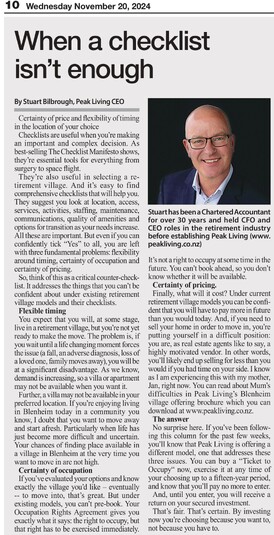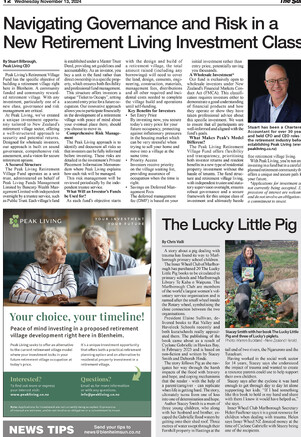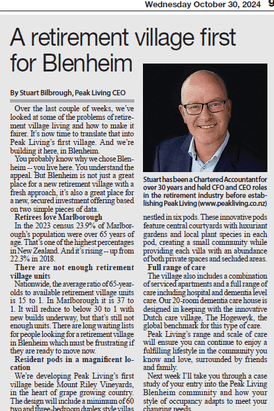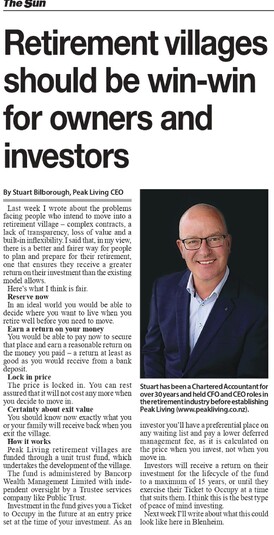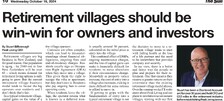Frequently Asked Questions
1. I have invested in the Blenheim Retirement Village Fund and now I want to move into another village owned by Peak Living in another location.
The first village development is proposed for Blenheim. Other opportunities are being sort in provincial locations throughout New Zealand. As other locations are confirmed it is Peak Living’s intention that you can transfer your entitlement to another village. We see this as one of the benefits of choosing a Peak Living retirement village. The transfer is expected to be based on availability and may incur additional cost based on location, age of the village and build configuration and current market value.
2. Same above but I want to move into another village not owned by Peak Living.
No. At this stage Peak Living does not have any relationships with other retirement village operators that will cater for this request. You would need to sell your investment through the secondary investment sales market.
3. Do I get preference for going into a higher level of care if I am a resident in the village? If I or my partner suddenly needs to move from my villa into hospital level care, will this be prioritised within the village?
The care offered in a Peak Living retirement village is primarily for village residents and therefore you will have priority over others in the local community needing care. This will be reliant on availability at the time of your request to move and may not guarantee a bed should there be no vacancies.
4. What if I only want to invest in the new retirement village fund but unlikely to want to live in the village?
You can. Whilst the investment has been developed primarily for those planning their futures in a retirement village, in their own community, the investment is also available to investors as well.
5. I have missed out on the original development and now want to invest to secure my entry price. How do I do this?
Contact Peak Living and they will advise if there is a current investor looking to withdraw their investment. There may also be opportunities to invest in other village developments and secure a place in the village of your choice.
6. I have not invested in the village and would like to become a resident. How will this work, and will I get kicked out of the unit I am in if an investor/resident is looking to move in?
Peak Living will operate like other retirement villages and in line with the provisions of the Retirement Villages Act 2003. You will pay an entry price set at the current market value under an ORA. This agreement ensures that you have a legal right to the villa until you decide to leave and not before.
7. Can an investor retain their investment after they move in, or do they have to convert to keep the agreed entry price?
No. When the resident investor converts their investment into occupancy (that is, moves in), they will enter an ORA and effectively transfer their investment from the Fund down to the Village Operating company. They convert this occupancy at the agreed price and their “ticket to occupy” is redeemed.
8. Can investors partially convert their investment?
An investor can make a partial investment. That is, if a unit entry price is $700,000 they can invest $70,000 that provides one tenth unit investment. On occupation a pro-rated entry price is calculated based on percentage of initial investment.
If an investor makes a full unit investment and then at a later date would like to partially withdraw from the Fund then this will need to be approved by the Fund Manager. That is, each situation will be considered on a case-by-case basis.
9. How many tickets will be sold? (How many investors competing to move into the village?)
Each village development will have a different need. We expect that the number of "tickets to occupy" available for the Blenheim Fund will range from forty to sixty investor units for a retirement village with approximately one hundred villas and apartments.
10. Do I own a unit or a part of the retirement village?
No you do not legally own a specific villa. Rather you hold an investment in the fund and the “ticket to occupy” provides a range of benefits including setting your entry price for a median priced unit when you decide to move into the retirement village and priority access above non-investors if there is a waiting list when you want to move into the village. We ask for three to six months warning prior to your intended move in date.
If you choose a more expensive unit you need to pay the difference at the market price at the time you move in. If you choose a cheaper unit, the difference is repaid to you in cash.
11. What if I want or need a different type of residence when I move in?
We expect that this is likely to be a common occurrence therefore have ensured full flexibility with this offering. The investment value will be set at the median unit price. If at the time you decide to move into the village you only require a serviced apartment, which has a lower price, you will be reimbursed the entry price difference at that time. This is vice versa if you decide the opposite.
12. What if I want to move in as soon the village is finished? Is there a minimum investment period?
There is no minimum investment period. There is only a maximum expected to be fifteen years. You can invest and move into the villa when available and receive all of the benefits that the “ticket to occupy” offers.
13. What if the village is full when I want to move in? Is there a guarantee if I give the required notice?
If the village is full then, as an investor and “ticket to occupy” holder, you receive priority access (note: there may be other ticket holders above you). We ask for three to six months warning of your decision to move into the retirement village and will maintain a waiting list. There may be other investors in the queue before you for a villa.
14. Will I be asked for more money when I move in? Will my ticket cover the entire entry for 15 years?
There will be no additional funds requested for the entry price unless you change your mind and request a different type of offering – villa verses serviced apartment verses different location, or if you choose a cheaper or more expensive unit. If you choose a more expensive unit you need to pay the difference at the market price at the time you move in. If you choose a cheaper unit, the difference is repaid to you in cash.
15. What condition will the retirement village and my villa be in 10-15 years later when I want to move in? Will there be guarantees of standards?
As the retirement village will need to attract new residents through its lifetime, it must remain at a high standard to rival and surpass its competition. A key focus of the design will to be around the environment, sustainability and longevity. All this surrounded by gardens that grow, develop and complement the village and surrounding community. The longer you wait the more established the planting will become and we see the village becoming more desirable as the years progress. Peak Living will also provide and share with residents the village's ongoing maintenance plan
16. What activities and facilities will be in the RV?
Please note that the ORA is still to be finalised. The design and planning for the village configuration is still to be confirmed. What is shown on this website may change considerably.
It is proposed that each retirement village will include integrated care from independent living through to hospital and dementia level care. The village will have a community centre which we see including rooms for doctor and physio visits, a large common room with bar and kitchen and small gym, exercise room and an undercover swimming pool if practical for the site and financially.
Depending on the location and configuration of the village there may be room for a pétanque or even a bowling green. Other options like BBQ pit and children’s playground will also be added based on appropriate space.
17. What happens after 15 years if I haven’t moved in?
The Fund is expected to come to an end after fifteen years. At that stage, the Fund will be wound up and any remaining investor units and their tickets to occupy not utilised will be withdrawn and paid back to the investor. This will include any accrued capital gains and any outstanding interest not paid.
Terms of the ticket to occupy such as priority access and DMF calculated on the initial investment will remain valid for a further period of time (to be confirmed).
18. You use $700,000 as the unit value for illustration in the brochure but what do you expect the approximate investment amount to be?
The investment amount for the Peak Living Blenheim Fund is still to be confirmed. It is expected to be $700,000, although it could be higher or lower. The amount will be dependent on the finalised configuration of the retirement village design and the outcome from resource and building consents. Consideration will also be given to comparable newly built retirement village offerings in the Marlborough region.
19. The deferred management fee (DMF) seems higher than other retirement villages?
The plan is to set the deferred management fee (DMF) at a level similar to other retirement village operators and in particular those offering a more boutique sized operation like Peak Living. As there is also a full range of care including hospital and dementia, a minimum level of DMF is required to cover this investment cost. Please note that the ORA is still to be finalised.
Your entry price for a median priced unit is set at the time of investment and therefore, on this basis, the dollar amount of DMF for that unit is also set at the time of investment.
By illustration:
You invest today at $700,000, the median unit value, and the DMF is say 30%. In the future the DMF portion you pay on exit from the village will be $210,000.
You move into the retirement village in say, ten years and pay $700,000. The median unit price is now $1,100,000. At the same DMF % on exit the payment would be $330,000 under the traditional retirement village business model.
Based on this example the Peak Living offering would save a resident who had invested ten years previously $120,000 in DMF. This is 36% less than under the traditional retirement village business model.
20. What guarantees are in place around the security of my investment and that the development will be completed?
At the onset of this retirement village development has been how Peak Living Limited and those providing fund administration and property development work together.
Peak Living Limited facilitates this through independent organisations bringing their expertise to the important components for the successful delivery of the Retirement Village development.
Each retirement village is funded through a Unit Trust Fund. This Fund provides funding through a loan facility to the village company to undertake the development of the village. The Fund is managed by the Fund Manager, who Peak Living has contracted to Bancorp Wealth Management Limited to look after as Fund Administrator. It is planned that the preferred independent oversight comes from trustee and fund custodian, Public Trust Limited. Prior to the start of the development Peak Living Management Limited will be also required to engage a village statutory supervisor. Our preference being Covenant Trustees.
Each development is completed by the most appropriate construction company for a particular location. Peak Living Management Limited has engaged Kensway Consultants to lead the selection and independent project management of the construction as it progresses.
Importantly, if resource consent is not approved all investors will be repaid in full. Land is settled after resource consent approval. We consider this approach reduces risk related to one point of failure impacting the whole development and investor funds.
21. I have invested into the Retirement Village Fund and now I want my money out. How do I do this?
You can notify us if you want to sell on your investment whenever you want, however an actual sale will be dependent on finding a replacement investor. This could take a few months or more. We cannot guarantee a secondary buyer will be available straight away or will be willing to pay for all capital appreciation that has accrued. You may also be able to withdraw from the Fund and be paid out the current value of your investment in certain circumstances and most likely when the village is established.
22. When I enter the village, do I get a capital movements at the end of the occupancy on exit?
The Occupation Right Agreement (ORA) will not give the resident any share in capital gain, and you will not be required to contribute to any capital loss on resale.
With your investment you will gain the benefit of paying today’s prices for a median priced unit in the village in the future, with no additional payment necessary when you decide to occupy a village unit, provided you move into a median priced unit.
If you choose a more expensive unit you need to pay the difference at the market price at the time you move in. If you choose a cheaper unit, the difference is repaid to you in cash. When you move into the village the investment changes into an ORA. The terms of the ORA are still to be formalised.
23. What happens to the village weekly fee? Does this remain the same when I invest or when I enter the village?
It is planned that the village weekly fee will be set when you enter the village. These fees are set at a level to cover operating expenses such as insurance, rates, common area maintenance, village staff costs etc. As costs go up so does the village fee. At Peak Living we are planning to hold fees flat from the day you enter the village as a resident. In rare situations a village fee may need to be increased due to increase fees annually at no more than annual inflation.
24. I have a preference of villa. What if it is unavailable when we decide it is time to move into the village?
We will make every effort to provide you with your preferred unit. Unfortunately, if it is occupied, we cannot move the current resident. If the villa becomes available after you have entered the village and on agreement with the village manager, you can move at that stage. Refurbishment and maintenance costs may apply.
25. Is there an age limit for the village and investing?
Not for investing but there is a maximum investment time horizon of fifteen years. To optimise the investment it is likely that the best time to invest would be in your 60’s and 70’s to take full advantage of the ticket to occupy. In keeping with village guidelines, you will normally be over 70 years old at the time of moving into the retirement village. Dependent on the size of your investment, consideration will be given to those over 65 years for village occupation. Refer to the information memorandum for further details.
26. What are the tax implications?
Returns to Unit holders are affected by taxation. The impact of taxation will vary depending upon each Unit holder's individual circumstances and all Unit holders should seek professional tax advice before investing. Neither Peak Living nor the Fund's Trustee can provide tax or investment advice and as such take no responsibility for the tax consequences that may arise as a result of investing in the Fund.
27. Why can Peak Living not provide the actual financial return investors will receive?
For the Peak Living Blenheim Retirement Village Fund offer, there is no practical way to advertise a projected return.
There are Funds available in New Zealand, and not related to Peak Living, that do but this is for the likes of for existing commercial buildings with a tenant or multiple tenants and where, for example, rental income, interest costs, and other expenses are well known and understood. They are also for a shorter period of time assisting with prediction accuracy.
This is not the case for this offer, as there is significant uncertainty about a range of variables.
28. Why are capital gains not shared with an investor, who becomes a Village resident, during the time that they are in the retirement village?
Peak Living seeks to provide an alternative to what is available in the retirement village industry in New Zealand. The objective is to achieve this, to an extent, through the Ticket to Occupy concept.
In evaluating options that provide an investor and future resident with a compelling proposition we have considered a multitude of options including capital movement sharing post occupancy and redemption of the Ticket to Occupy.
As part of Peak Livings value sharing approach, providing certainty to an investor and future resident was a very important consideration. We consider providing a lower deferred management fee option provide greater assurance than a more speculative share in post village entry capital gains or even losses.
29. Is there actually an occupation option priced at exactly the same as the median price of $700,000?
There will be a range of entry price occupation options based on:
Type – 2-bedroom villa, 3-bedroom villa, serviced apartment and care suite
Location in village
Position in sub community – for example, the Pod layout of four villas may be priced based on position – end villas verses middle villas.
Despite this range there are likely to be villas priced at $700,000 but it may be a smaller percentage of the total number of entry price and occupation options. This is to be confirmed. Although the likes of the 2-bedroom villa will be materially similar across all 2-bedroom villas there is likely to be some sort of payment or refund based on the median unit value valuation at the time. A much larger payment for 3-bedroom and much larger refund for serviced apartments.
30. I am really keen to secure my place in the retirement village but I am unsure if I am eligible to invest?
Interested investors will not be able to invest without proof and auditable certification that they have discussed the investment and its details with their accountant, lawyer or financial advisor and show a good level of understanding. It will also require their accountant, lawyer or financial advisor to certify the investor meets eligible investor criteria.
Although this is an onerous requirement, if the investor also includes discussion about future occupation right agreement (ORA) documentation, this time will be valuable for the investors understanding of not only the Peak Living Blenheim Retirement Village Fund investment but understanding early the complexities and legal documentation related to the retirement village they will one day move into well before they need to.
Further guidelines related to investor eligibility will be made available on request through the Peak Living Blenheim Retirement Village Fund Information Memorandum.
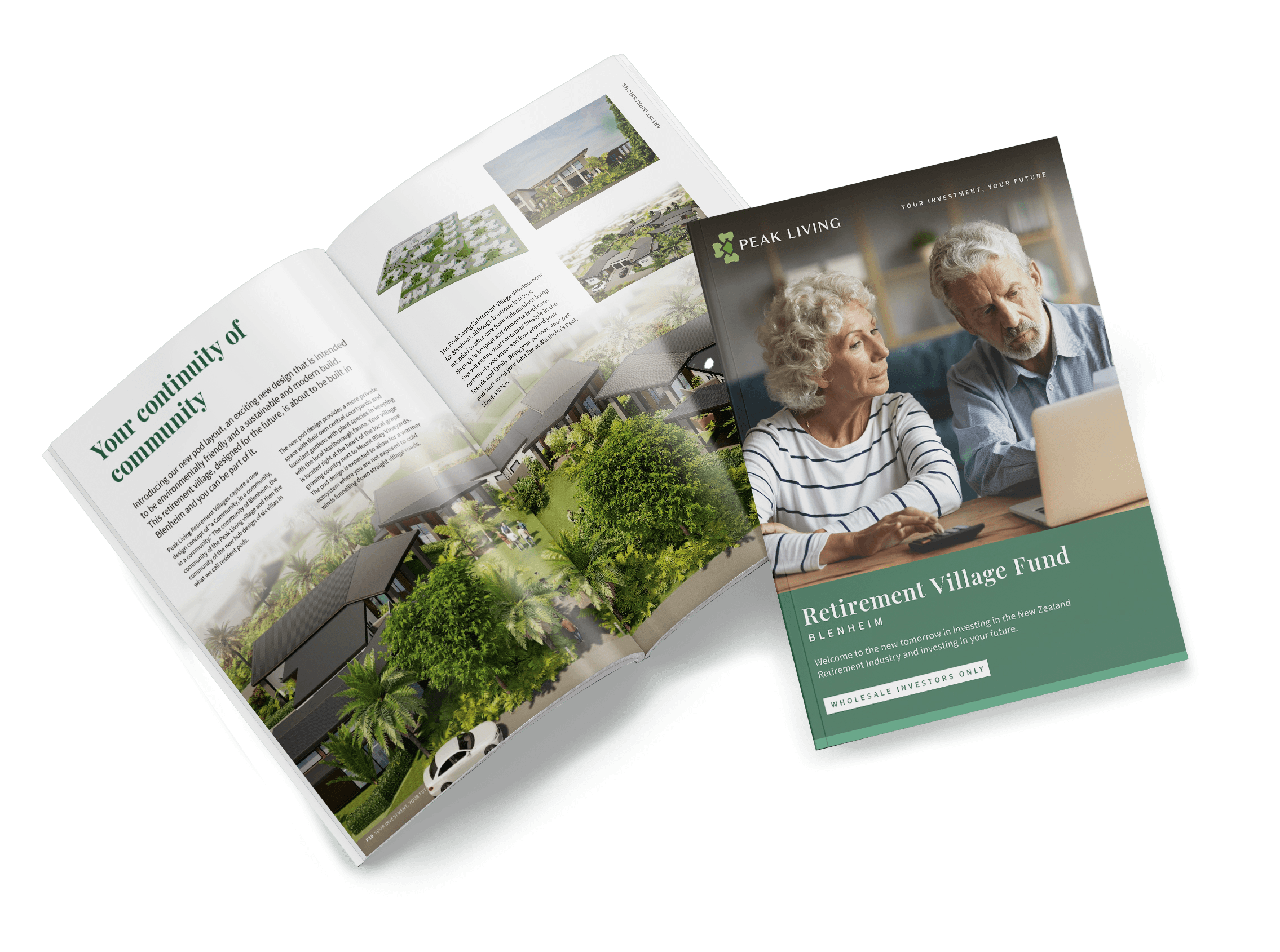
Invest now for a smooth transition into your retirement later.
Invest today and enjoy tomorrow with Peak Living.
